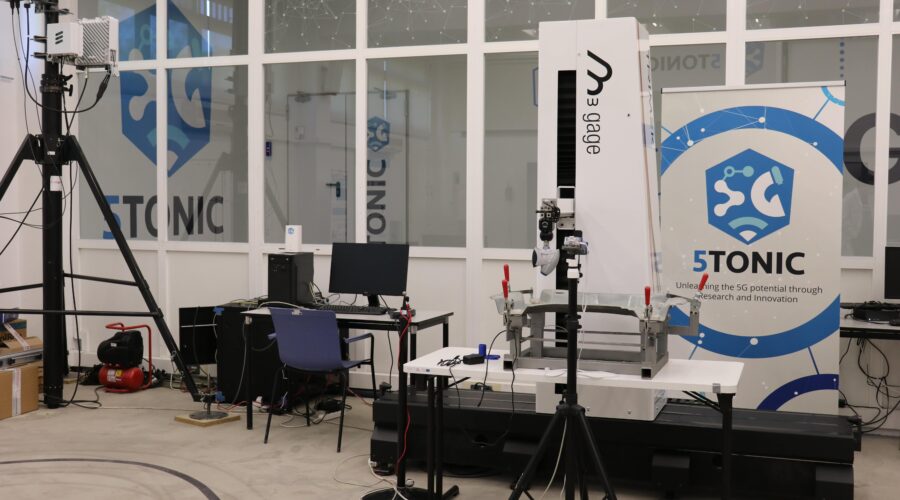IMDEA Networks

5TONIC laboratory completes pioneering tight integration between 5G SA network and Edge platform
Emerging edge use cases such as connected cars, gaming, and safety & security are examples along with more traditional IoT use cases that benefit from these transformative applications based on real-time network conditions
14 April 2021

One of the world’s first tight integrations between 5G standalone (SA) core network and Multiaccess Edge Computing platform has been developed by Capgemini Engineering, Ericsson, Intel and Telefonica at the 5TONIC lab, an open Innovation laboratory for 5G technologies founded by Telefónica and IMDEA Networks in Madrid. Innovative use cases were developed in collaboration with DeepSight Al Labs to demonstrate its capabilities, showing that Edge application can now adapt to varying network conditions and be optimized to deliver a consistent service.
The integration enables third party developers to launch customized Edge applications for rapidly growing areas such as safety & security, connected cars, mobile gaming as well as innovation in traditional IoT uses cases by combining robust connectivity, ultra-fast information processing dynamic network optimization in real-time.
Edge computing value proposition
User’s and enterprises’ demands for enhanced performance plus improved privacy and security are shaping the design of their digital applications at the Edge. This platform provides computing, storage and connectivity capabilities to enterprises and software developers who are delivering innovative solutions directly to customer devices. These scalable data centers can vary in size, location and capacity and can be deployed within mobile, fixed and/or enterprise networks. Deploying applications in these locations enables real-time processing, guaranteed bandwidth, and increased privacy and security.
Edge reduces latency, diminishes devices’ computational needs, and lowers ineffective use of communication capacity. It plays an important role in delivering some of the promises of ultra-low latency and ultra-high reliability in 5G networks. MEC combines the benefits of both, cloud solutions’ affordability and scalability, and on-premise solutions’ performance and convenience.
A pioneering integration between a 5G SA network and an Intelligent Edge platform
This innovation is based within Ericsson’s Cloud Core Exposure Server (CCES) including 3GPP defined Network Exposure Functions (NEF), and APIGw Exposure Layer. It was built with Capgemini Engineering’s ENSCONCE Edge platform, powered by Intel OpenNESS and OpenVINO technologies and integrated with Ericsson’s 5G core. The platform was tested using DeepSight AI Lab’s image processing and video analytics to measure the performance based on a variety of network conditions.
Intel provided the technology foundation with their Intel Xeon Scalable processors with built-in AI acceleration to optimize the network infrastructure. OpenNESS, an open source software toolkit enables, a cloud-native and edge-computing platform, and its mobile networking building blocks enable the platform to dynamically steer traffic between a mobile network and destination applications. These building blocks accelerate customer time-to-value by providing reference implementations for 3GPP network components. Intel’s Distribution of OpenVINO toolkit takes advantage of CPUs integrated with Intel DL Boost acceleration with bfloat16 to speed up computer vision workloads and streamline deep learning inference and deployment.
DeepSight AI Labs platform is a compilation of 3 technologies – 5G, Computer Vision for CCTV cameras/Drones and IoT. The platform is interoperable with various MEC platforms which are deployed on 5G networks where all the video feeds will be directed for real-time analysis to detect events like plant management, accidents, large-scale crowd management, etc. DeepSight has enabled customers to develop various use cases significantly faster to lead the race in deploying AI solutions to protect and increase productivity, the efficiency of the employee, monitor critical plants, quality of manufacturing, etc. DeepSight AI Labs has built multiple Computer Vision Platforms that simplify the complex AI Pipeline to develop the feature and roll out new feature in just 2 to 3 weeks with high accuracy and it is working extensively with the telecom and banking industries and integrating with the MEC platform player to deliver video analytics features at network edge.
Juan Carlos Garcia, President of 5TONIC and SVP of Innovation at Telefonica highlights: “5G core integration with Telco edge platforms strengthens our capability to offer an enhanced experience at the edge to end users and developers. The Network Exposure Function is a key enabler to allow a fast integration of third-party platforms to access 5G functionalities opening the door to Network as a Service use cases such as on-demand QoS based on application criticality. We look forward to continuing exploring new use cases such as mobility enhancement and dynamic user plane routing for edge computing”.
About 5TONIC
5TONIC was founded by Telefónica and IMDEA Networks Institute with a clear vision to create an open research and innovation ecosystem laboratory in which industry and academia come together to boost technology and business innovative ventures. The laboratory promotes joint project development, joint entrepreneurial ventures, discussion fora, events and conference sites, all in an international environment of the highest impact. 5TONIC serves to show the capabilities and interoperation of pre-commercial 5G equipment, services and applications, by leading global companies in the 5G arena. The laboratory was recently awarded Digital Innovation Hub status by the European Commission.



Recent Comments